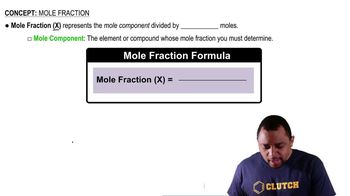Here are the essential concepts you must grasp in order to answer the question correctly.
Vapor Pressure
Vapor pressure is the pressure exerted by a vapor in equilibrium with its liquid or solid phase at a given temperature. It reflects the tendency of particles to escape from the liquid phase into the vapor phase. The higher the vapor pressure, the more volatile the substance. In this question, the vapor pressures of chloroform and dichloromethane at 25 °C are essential for calculating the total vapor pressure of their mixture.
Recommended video:
Raoult's Law and Vapor Pressure
Raoult's Law
Raoult's Law states that the vapor pressure of a solvent in a solution is directly proportional to the mole fraction of the solvent in the mixture. This principle allows us to calculate the partial vapor pressures of each component in a mixture based on their individual vapor pressures and their respective mole fractions. Applying Raoult's Law is crucial for determining the total vapor pressure of the mixture of CHCl₃ and CH₂Cl₂.
Recommended video:
Raoult's Law and Vapor Pressure
Mole Fraction
Mole fraction is a way of expressing the concentration of a component in a mixture, defined as the number of moles of that component divided by the total number of moles of all components in the mixture. It is a dimensionless quantity that helps in calculating the contributions of each component to the overall properties of the mixture, such as vapor pressure. In this problem, calculating the mole fractions of CHCl₃ and CH₂Cl₂ is necessary to apply Raoult's Law effectively.
Recommended video:



